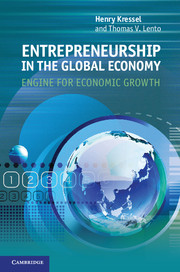Book contents
- Frontmatter
- Contents
- Figures
- Tables
- Acknowledgments
- Introduction
- 1 Government: Boss, financial partner, regulator – Entrepreneurs in mixed economies
- 2 Standing still is not an option: On promoting entrepreneurship and economic growth
- 3 Electronic innovation and the government: David Sarnoff creates the RCA empire
- 4 Global problem, golden opportunity: Ron Stanton profits from market disruption
- 5 Speeding voice and data traffic worldwide: Network microprocessors from RMI
- 6 A world leader emerges: SanDisk and flash memories
- 7 Implementing information technology across the globe
- 8 Three startups in China: Entrepreneurs in a controlled economy
- 9 Connecting the wireless networks of the world
- 10 Building an economy: Government planning vs. entrepreneurial innovation
- Select bibliography
- Index
- References
5 - Speeding voice and data traffic worldwide: Network microprocessors from RMI
Published online by Cambridge University Press: 05 August 2012
- Frontmatter
- Contents
- Figures
- Tables
- Acknowledgments
- Introduction
- 1 Government: Boss, financial partner, regulator – Entrepreneurs in mixed economies
- 2 Standing still is not an option: On promoting entrepreneurship and economic growth
- 3 Electronic innovation and the government: David Sarnoff creates the RCA empire
- 4 Global problem, golden opportunity: Ron Stanton profits from market disruption
- 5 Speeding voice and data traffic worldwide: Network microprocessors from RMI
- 6 A world leader emerges: SanDisk and flash memories
- 7 Implementing information technology across the globe
- 8 Three startups in China: Entrepreneurs in a controlled economy
- 9 Connecting the wireless networks of the world
- 10 Building an economy: Government planning vs. entrepreneurial innovation
- Select bibliography
- Index
- References
Summary
The network will truly be the computer.
If you happen to make a wireless phone call to China, it may be routed through a microprocessor chip produced by Raza Microelectronics Inc. Although RMI (later merged with NetLogic Microsystems) only began supplying integrated circuits in mid-2005, its microprocessors now power some of the most advanced communications network equipment in the world, and it counts the leading Chinese equipment suppliers among its customers. It has become the acknowledged technology leader in its chosen market.
How a Silicon Valley startup developed the world’s most sophisticated network microprocessor is a remarkable story. It is also especially relevant to our theme of global entrepreneurship, because RMI’s success hinged as much on its understanding of international markets as on its technical expertise.
RMI’s management realized early on that overseas markets were more open to network chip innovations from a startup than the domestic US equipment manufacturers, who had well-established chip suppliers with long-standing reputations. So the company decided that its primary sales target should be China, the world’s fastest-growing network equipment maker.
- Type
- Chapter
- Information
- Entrepreneurship in the Global EconomyEngine for Economic Growth, pp. 131 - 148Publisher: Cambridge University PressPrint publication year: 2012



